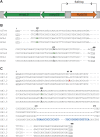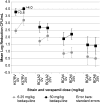Acquired resistance of Mycobacterium tuberculosis to bedaquiline
- PMID: 25010492
- PMCID: PMC4092087
- DOI: 10.1371/journal.pone.0102135
Acquired resistance of Mycobacterium tuberculosis to bedaquiline
Abstract
Bedaquiline (BDQ), an ATP synthase inhibitor, is the first drug to be approved for treatment of multi-drug resistant tuberculosis in decades. In vitro resistance to BDQ was previously shown to be due to target-based mutations. Here we report that non-target based resistance to BDQ, and cross-resistance to clofazimine (CFZ), is due to mutations in Rv0678, a transcriptional repressor of the genes encoding the MmpS5-MmpL5 efflux pump. Efflux-based resistance was identified in paired isolates from patients treated with BDQ, as well as in mice, in which it was confirmed to decrease bactericidal efficacy. The efflux inhibitors verapamil and reserpine decreased the minimum inhibitory concentrations of BDQ and CFZ in vitro, but verapamil failed to increase the bactericidal effect of BDQ in mice and was unable to reverse efflux-based resistance in vivo. Cross-resistance between BDQ and CFZ may have important clinical implications.
Conflict of interest statement
Figures



References
-
- Cohen J (2013) Infectious disease. Approval of novel TB drug celebrated–with restraint. Science 339: 130. - PubMed
-
- Andries K, Verhasselt P, Guillemont J, Gohlmann HW, Neefs JM, et al. (2005) A diarylquinoline drug active on the ATP synthase of Mycobacterium tuberculosis. Science 307: 223–227. - PubMed
Publication types
MeSH terms
Substances
Associated data
LinkOut - more resources
Full Text Sources
Other Literature Sources
Medical

